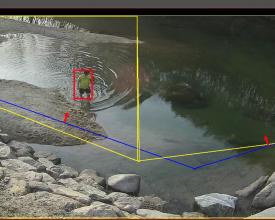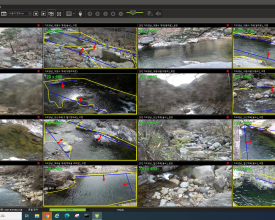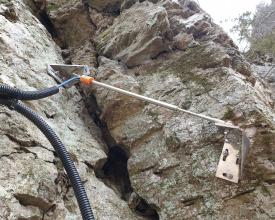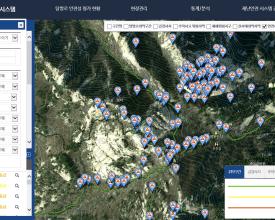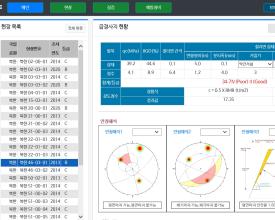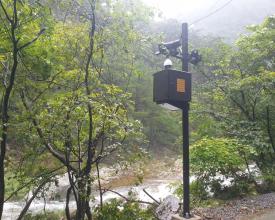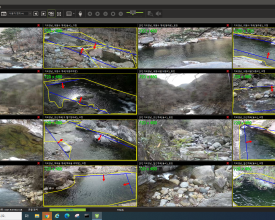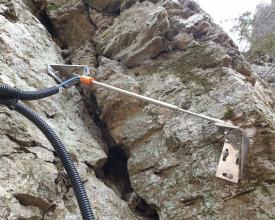
Système de gestion de la sécurité des visiteurs des parcs nationaux coréens basé sur l'IA
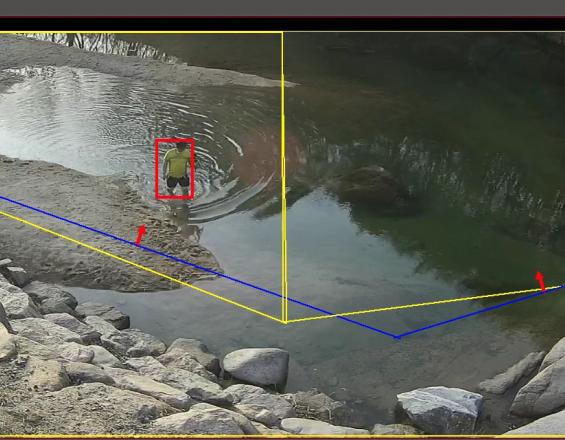
"Existe-t-il des solutions innovantes pour permettre aux visiteurs des parcs nationaux de rencontrer la nature sans risque de danger ?" Les préoccupations de longue date des gardes forestiers coréens ont commencé à obtenir de grands résultats en établissant un système de gestion de la sécurité des visiteurs basé sur l'IA et utilisant les dernières technologies. Ce système surveille et analyse automatiquement, 24 heures sur 24, les zones de danger potentiel dans les parcs nationaux en combinant des équipements de mesure tels que la télévision en circuit fermé, la jauge de fissure et l'intelligence artificielle. Lorsque des signes de danger sont identifiés, une alarme est envoyée au site où séjournent les visiteurs et au centre de contrôle du bureau du parc national pour assurer le suivi et prévenir les risques à l'avance. 89 caméras de surveillance intelligentes ont été installées dans 15 parcs nationaux depuis 2020, et 525 jauges de fissures automatiques et manuelles ont été utilisées dans 174 zones à risque d'éboulement dans 21 parcs nationaux depuis 2013.
Contexte
Défis à relever
1. Il a été difficile de sélectionner l'emplacement optimal où les équipements sont utilisés. Pour ce faire, une analyse spatiale des accidents de visiteurs survenus dans le passé a été utilisée, et des gardes forestiers et des experts compétents ont mené des enquêtes sur le terrain pour trouver le meilleur endroit où faire fonctionner l'équipement.
2) La technologie d'apprentissage en profondeur utilisée par la télévision en circuit fermé intelligente a rarement reconnu à tort des animaux comme étant des humains. Ces problèmes techniques seront résolus une fois que l'algorithme aura été amélioré et qu'un volume d'apprentissage suffisant aura été réalisé.
3. Comme il n'existait pas de jauge de fissure commerciale adaptée aux accidents de chutes de pierres dans les parcs nationaux, les chercheurs du KNPS ont travaillé ensemble pour améliorer l'appareil qui convient à l'environnement des parcs nationaux coréens, et ils ont obtenu un brevet.
Emplacement
Traiter
Résumé du processus
Toutes les informations et données relatives à la sécurité des visiteurs dans les parcs nationaux sont collectées et gérées dans un système intégré de prévention des catastrophes. Comme la vidéosurveillance intelligente basée sur l'IA et la jauge de fissure basée sur l'IA font partie du système dans son ensemble, elles sont compatibles entre elles et surveillées ensemble, ce qui renforce encore la gestion de la sécurité dans les parcs nationaux coréens.
Blocs de construction
La vidéosurveillance intelligente basée sur l'IA
La vidéosurveillance intelligente basée sur l'IA est un système de gestion scientifique de la sécurité qui utilise la technologie d'apprentissage profond pour contrôler les urgences en analysant les images en temps réel. En reconnaissant et en analysant les comportements anormaux, tels que l'intrusion, les cris, l'errance, etc., un message d'alerte est immédiatement envoyé au site et transmis au système de contrôle, après les interventions d'urgence.
En outre, dans le cas des parcs nationaux marins/côtiers présentant un risque élevé d'accidents de sécurité dus aux marées et aux marées, la diffusion des heures de marée est automatiquement émise sur le site. La vidéosurveillance intelligente a été installée en 2020 et est actuellement exploitée dans 89 endroits de 15 parcs nationaux.
Facteurs favorables
Le facteur de réussite le plus important est de choisir l'emplacement optimal où l'équipement peut être utilisé efficacement. La vidéosurveillance intelligente a été installée en sélectionnant des zones où des accidents de noyade se produisaient fréquemment dans le passé. Un autre facteur de réussite est de disposer d'un ensemble de systèmes pour faire face aux situations d'urgence. Lorsque le système d'alarme IA est activé, le centre de contrôle général du siège de la KNPS vérifie la diffusion en temps réel afin de saisir rapidement la situation, puis les équipes de secours des parcs nationaux se rendent sur place pour commencer les opérations de sauvetage.
Leçon apprise
La vidéosurveillance intelligente basée sur l'IA est un système de gestion scientifique de la sécurité qui utilise la technologie de l'apprentissage profond. Afin d'améliorer continuellement la précision de l'apprentissage en profondeur, des experts continuent de maintenir le logiciel et de fournir une assistance technique sur le terrain afin qu'il puisse être géré de manière stable. Au fur et à mesure que les données relatives à l'apprentissage profond s'accumulent, le niveau de fonctionnement du système devrait augmenter. Sur la base de ces réalisations et de ces limites, il est nécessaire d'améliorer progressivement les nombreux systèmes de vidéosurveillance qui ont été surveillés par le personnel à l'aide de cette technologie innovante, dans le cadre du système de gestion de la sécurité du KNPS.
Jauge de fissure basée sur l'IA pour les chutes de pierres
La jauge de fissure basée sur l'IA pour les chutes de pierres est un dispositif qui surveille l'occurrence des chutes de pierres et les déplacements des fissures en temps réel en installant un capteur d'observation dans une zone à risque de chute de pierres située le long du sentier. Depuis 2013, des jauges de fissures automatiques et manuelles ont été installées sur des pentes abruptes présentant un risque élevé d'effondrement, et 525 unités sont actuellement en service sur 174 sites. Le dispositif de mesure des chutes de pierres est divisé en niveaux de risque : "intérêt", "prudence", "alerte" et "grave". Au stade de l'intérêt, des inspections régulières et fréquentes sont effectuées. Au stade de la prudence, lorsque les fissures sont inférieures à 5 mm et à 2°, la surveillance est renforcée. Au stade de l'alerte, une enquête précise et des plans d'action en cas de catastrophe sont préparés. Dans la phase de gravité, les sentiers adjacents sont contrôlés et des mesures d'urgence telles que l'enlèvement des chutes de pierres sont mises en œuvre.
Facteurs favorables
Avant l'installation de la jauge de fissure basée sur l'IA, une équipe d'enquête spécialisée composée de géologues et d'experts en prévention des catastrophes a été mise en place pour gérer systématiquement les chutes de pierres et les pentes raides afin d'étudier les zones présentant un risque d'accident dû aux chutes de pierres le long des sentiers des parcs nationaux. En outre, les zones dangereuses pour la sécurité ont été classées de A à E en fonction du degré de risque, de l'inclinaison et d'autres caractéristiques géologiques, et converties en bases de données.
Leçon apprise
81 chutes de pierres se sont produites dans le parc national au cours des 10 dernières années, faisant 3 morts et 6 blessés, et endommageant des propriétés pour un montant d'environ 2,1 milliards de KRW. Cependant, depuis 2018, lorsque la jauge de fissure basée sur l'IA a été utilisée, il n'y a pas eu de décès ou de blessures pour les visiteurs en raison des chutes de pierres. En outre, il fallait beaucoup de temps et de travail pour inspecter une à une toutes les jauges de fissures installées dans l'ensemble du parc national. Grâce au temps gagné, les gardes forestiers peuvent se concentrer davantage sur d'autres activités de gestion du parc, ce qui a grandement amélioré la satisfaction interne.
Ressources
Impacts
Auparavant, les gardes forestiers du centre de contrôle surveillaient tous les signaux sur l'écran pour identifier les dangers. Cependant, depuis l'introduction des dispositifs intelligents basés sur l'IA, ceux-ci détectent les signaux anormaux 24 heures sur 24 et envoient automatiquement une alarme au site et au centre de contrôle, ce qui aide grandement les gardes du parc à répondre aux urgences, même en l'absence du personnel de surveillance.
Depuis l'introduction de ces dispositifs, il n'y a eu aucune victime due à des jeux d'eau ou à des chutes de pierres dans les parcs nationaux coréens. Le service des parcs nationaux coréens (KNPS) a reçu en 2020 la mention élogieuse du Premier ministre pour la sécurité de l'eau. Le niveau de fonctionnement des systèmes de gestion de la sécurité des visiteurs basés sur l'IA devrait s'améliorer considérablement au fur et à mesure de l'accumulation des données pour l'apprentissage en profondeur.
Bénéficiaires
Environ 45 millions de visiteurs se rendent chaque année dans les parcs nationaux de Corée, et tous sont des bénéficiaires potentiels. La charge de travail du personnel de surveillance a également été considérablement réduite.
Objectifs de développement durable
Histoire
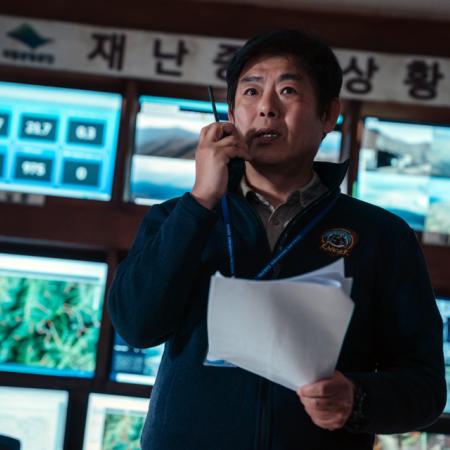
Lorsque l'alarme retentit dans le centre de contrôle, les personnes qui arrivent sur le site avant le 119 sont les équipes de secours du parc national. Elles se mobilisent plusieurs fois par jour pour sauver quelqu'un avant qu'il ne meure, et elles sont prêtes à sortir pour protéger les visiteurs même par mauvais temps ou dans des situations où leur vie est en danger. Beaucoup de gens ont été inspirés en les voyant naviguer dans la nature sauvage, et en 2021, le drame "Jirisan" avec le motif de l'équipe de sauvetage du parc national a été diffusé - Jirisan est le premier parc national en Corée et est inscrit sur la liste verte de l'UICN. Dans ce feuilleton, des acteurs coréens de premier plan tels que Jeon Ji-Hyeon, Ju Ji-hoon et Seong Dong-il ont interprété la vie quotidienne de l'équipe de sauvetage du parc national, et les magnifiques paysages naturels ont servi de toile de fond au feuilleton. Au milieu du feuilleton, divers systèmes de gestion de la sécurité utilisés par le Service des parcs nationaux de Corée (KNPS) ont également été présentés, ce qui a ajouté au plaisir de regarder le feuilleton.

